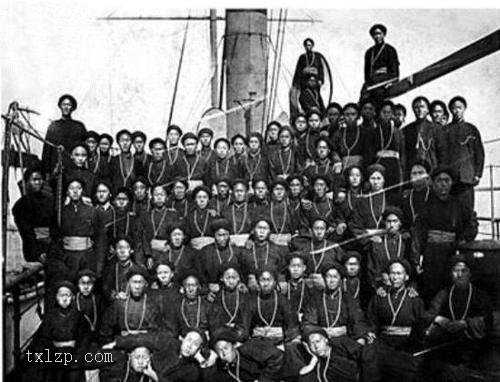Period:Song dynasty Production date:10thC-13thC
Materials:jade
Technique:carved, incised,
Subjects:camel
Dimensions:Height: 3.80 centimetres Length: 7.80 centimetres
Description:
Jade carving of a reclining camel, the compact beast with head turned and resting on the ground, the feet folded under the animal, the ears pointed and lying back, the middle of the short tail standing free from the body; the stone translucent and of near-white colour with light brown markings on the mane.
IMG
![图片[1]-figure BM-2022-3034.261-China Archive](https://chinaarchive.net/Song dynasty/Jades/684_2.jpg)
![图片[2]-figure BM-2022-3034.261-China Archive](https://chinaarchive.net/Song dynasty/Jades/mid_684_1.jpg)
Comments:Song dynasty or later. This is an extraordinarily fine carving. The carver has taken advantage of the pebble shape to create a camel: its legs are folded under its body and its long neck curves down so that its head rests on the ground. The hooves and the tufted hair on its back are clearly marked with incised lines, and a heavy mane of incised lines follows the curve of the neck. The creature is rather more elaborate and mannered than some of the earlier carvings, with slightly angled lines defining the limbs and a dimpled surface suggesting muscles. The ribs are indicate don both sides by deep incised lines. Dimples indicate the bones below the muscles of the face and the mouth and nostrils are represented by deep curved lines. A large round eye incised with concentric circles is probably the most striking feature of the beast. There are tufts of hair indicated by incised lines over the forehead and under the chin as a beard. Only the small, striated tail stands free of the body. The almost flat underside and compact, relatively solid form of the creature suggest that it was probably a paper weight. Camels in all materials, ceramic, wood, stone and jade, have been traditionally associated with the Tang dynasty when trade with Central Asia no doubt stimulated an interest in the creatures. Magnificent ceramic examples appear in imperial Tang tombs, but they are not, however, found among the stone sculpture of Tang tomb avenues. The fact that camels were present inside but not outside a particular tomb tells us something about the status of the camel in the Tang dynasty. The camel was obviously essential to the support and protection of the tomb occupant. it probably also helped in his self definition, suggesting a certain status and wealth, due to the camel’s link with Central Asia, source of luxuries and other wonders. But the absence of the camel from tomb avenues suggests that it was not part of the wider Tang definition of the essential creatures of the universe. It thus seems that the camel was by no means as important as say the horse, the dragon, or imaginary creatures with wings and horns, such as bixie or mythical deer-like animals, known as tianlu. The surviving camels in jade are not especially like the ceramic tomb models. Despite this, many of them have been assigned to the period. Several are curled around themselves, lying on the ground, a position not found in the ceramic versions. Further the goods carried by the camel were very important to their owners, and while these are often shown on the ceramic figures, they do not appear in jade. It is possible that some may have been paper weights, although Tang period weights are likely to have had square bases. Stylistically there are no obvious reasons why the surviving camels should be dated to the Tang, although some may belong to that period. Only a few of the surviving examples bear the deeply scored lines typical of Tang work, seen for example on the ornaments, nos.691 [2014,AsiaLoan,1.237] and 689. If the surviving jade camels were white like the present piece, we would have a stronger argument for linking them with cults of immortality and dating them to the Tang period. While it would be attractive to argue that the present camel is a Tang piece, linked to journeys to the mountains of Kunlun, the home of the Queen Mother of the West, there is no strong evidence to support such a thesis. For the present a later date is suggested on the grounds that the piece may be a paper weight, a genre especially popular from the Song period, but this opinion may well be revised in the light of future evidence. See Rawson 1995, p.368, cat.no.26.12. Song Dynasty (960-1279). Length 8.2 cm.
Materials:jade
Technique:carved, incised,
Subjects:camel
Dimensions:Height: 3.80 centimetres Length: 7.80 centimetres
Description:
Jade carving of a reclining camel, the compact beast with head turned and resting on the ground, the feet folded under the animal, the ears pointed and lying back, the middle of the short tail standing free from the body; the stone translucent and of near-white colour with light brown markings on the mane.
IMG
![图片[1]-figure BM-2022-3034.261-China Archive](https://chinaarchive.net/Song dynasty/Jades/684_2.jpg)
![图片[2]-figure BM-2022-3034.261-China Archive](https://chinaarchive.net/Song dynasty/Jades/mid_684_1.jpg)
Comments:Song dynasty or later. This is an extraordinarily fine carving. The carver has taken advantage of the pebble shape to create a camel: its legs are folded under its body and its long neck curves down so that its head rests on the ground. The hooves and the tufted hair on its back are clearly marked with incised lines, and a heavy mane of incised lines follows the curve of the neck. The creature is rather more elaborate and mannered than some of the earlier carvings, with slightly angled lines defining the limbs and a dimpled surface suggesting muscles. The ribs are indicate don both sides by deep incised lines. Dimples indicate the bones below the muscles of the face and the mouth and nostrils are represented by deep curved lines. A large round eye incised with concentric circles is probably the most striking feature of the beast. There are tufts of hair indicated by incised lines over the forehead and under the chin as a beard. Only the small, striated tail stands free of the body. The almost flat underside and compact, relatively solid form of the creature suggest that it was probably a paper weight. Camels in all materials, ceramic, wood, stone and jade, have been traditionally associated with the Tang dynasty when trade with Central Asia no doubt stimulated an interest in the creatures. Magnificent ceramic examples appear in imperial Tang tombs, but they are not, however, found among the stone sculpture of Tang tomb avenues. The fact that camels were present inside but not outside a particular tomb tells us something about the status of the camel in the Tang dynasty. The camel was obviously essential to the support and protection of the tomb occupant. it probably also helped in his self definition, suggesting a certain status and wealth, due to the camel’s link with Central Asia, source of luxuries and other wonders. But the absence of the camel from tomb avenues suggests that it was not part of the wider Tang definition of the essential creatures of the universe. It thus seems that the camel was by no means as important as say the horse, the dragon, or imaginary creatures with wings and horns, such as bixie or mythical deer-like animals, known as tianlu. The surviving camels in jade are not especially like the ceramic tomb models. Despite this, many of them have been assigned to the period. Several are curled around themselves, lying on the ground, a position not found in the ceramic versions. Further the goods carried by the camel were very important to their owners, and while these are often shown on the ceramic figures, they do not appear in jade. It is possible that some may have been paper weights, although Tang period weights are likely to have had square bases. Stylistically there are no obvious reasons why the surviving camels should be dated to the Tang, although some may belong to that period. Only a few of the surviving examples bear the deeply scored lines typical of Tang work, seen for example on the ornaments, nos.691 [2014,AsiaLoan,1.237] and 689. If the surviving jade camels were white like the present piece, we would have a stronger argument for linking them with cults of immortality and dating them to the Tang period. While it would be attractive to argue that the present camel is a Tang piece, linked to journeys to the mountains of Kunlun, the home of the Queen Mother of the West, there is no strong evidence to support such a thesis. For the present a later date is suggested on the grounds that the piece may be a paper weight, a genre especially popular from the Song period, but this opinion may well be revised in the light of future evidence. See Rawson 1995, p.368, cat.no.26.12. Song Dynasty (960-1279). Length 8.2 cm.
© Copyright
The copyright of the article belongs to the author, please keep the original link for reprinting.
THE END



![[Qing Dynasty] British female painter—Elizabeth Keith, using woodblock prints to record China from the late Qing Dynasty to the early Republic of China—1915-China Archive](https://chinaarchive.net/wp-content/uploads/2022/11/image-191x300.png)

